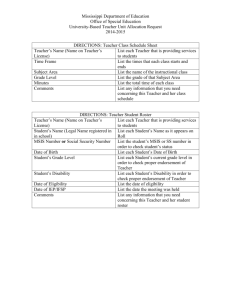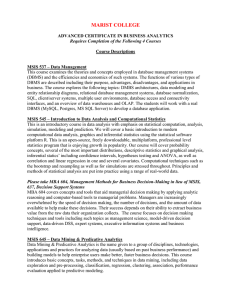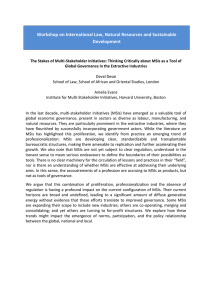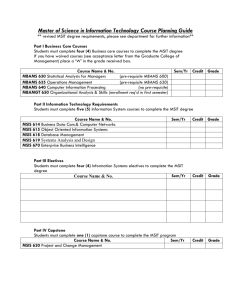Using Educational Data to Increase Learning, Retention, and Degree Attainment
advertisement
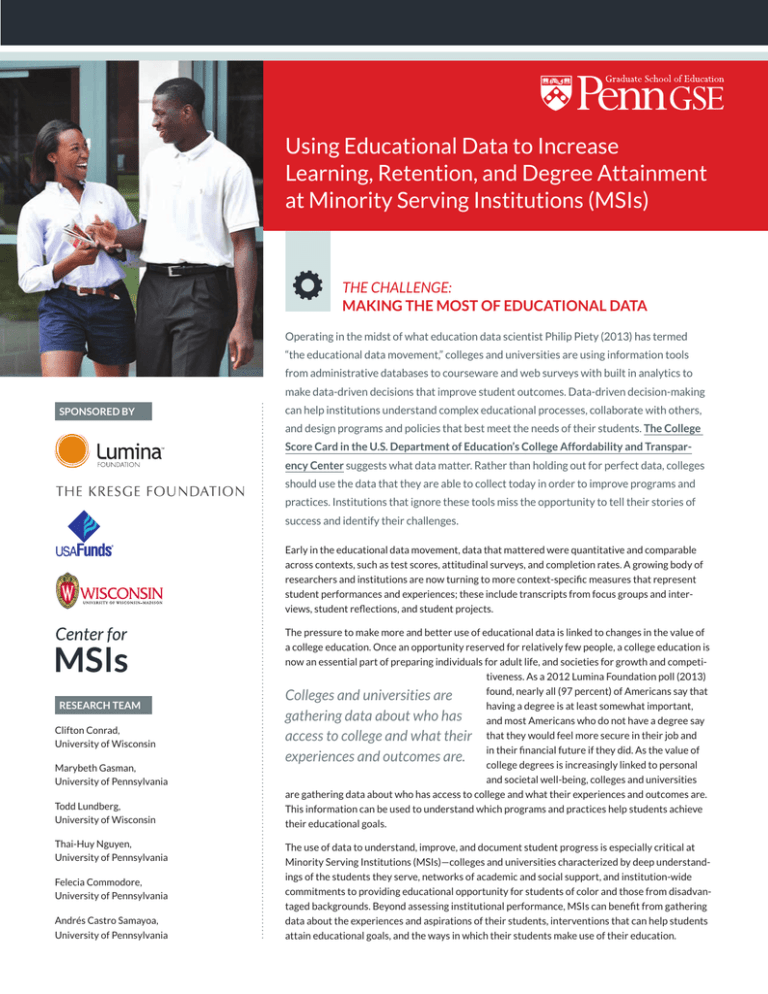
Using Educational Data to Increase Learning, Retention, and Degree Attainment at Minority Serving Institutions (MSIs) The Challenge: Making the Most of Educational Data Operating in the midst of what education data scientist Philip Piety (2013) has termed “the educational data movement,” colleges and universities are using information tools from administrative databases to courseware and web surveys with built in analytics to make data-driven decisions that improve student outcomes. Data-driven decision-making Sponsored by can help institutions understand complex educational processes, collaborate with others, and design programs and policies that best meet the needs of their students. The College Score Card in the U.S. Department of Education’s College Affordability and Transparency Center suggests what data matter. Rather than holding out for perfect data, colleges should use the data that they are able to collect today in order to improve programs and practices. Institutions that ignore these tools miss the opportunity to tell their stories of success and identify their challenges. Early in the educational data movement, data that mattered were quantitative and comparable across contexts, such as test scores, attitudinal surveys, and completion rates. A growing body of researchers and institutions are now turning to more context-specific measures that represent student performances and experiences; these include transcripts from focus groups and interviews, student reflections, and student projects. Research Team Clifton Conrad, University of Wisconsin Marybeth Gasman, University of Pennsylvania Todd Lundberg, University of Wisconsin Thai-Huy Nguyen, University of Pennsylvania Felecia Commodore, University of Pennsylvania Andrés Castro Samayoa, University of Pennsylvania The pressure to make more and better use of educational data is linked to changes in the value of a college education. Once an opportunity reserved for relatively few people, a college education is now an essential part of preparing individuals for adult life, and societies for growth and competitiveness. As a 2012 Lumina Foundation poll (2013) found, nearly all (97 percent) of Americans say that Colleges and universities are having a degree is at least somewhat important, gathering data about who has and most Americans who do not have a degree say access to college and what their that they would feel more secure in their job and in their financial future if they did. As the value of experiences and outcomes are. college degrees is increasingly linked to personal and societal well-being, colleges and universities are gathering data about who has access to college and what their experiences and outcomes are. This information can be used to understand which programs and practices help students achieve their educational goals. The use of data to understand, improve, and document student progress is especially critical at Minority Serving Institutions (MSIs)—colleges and universities characterized by deep understandings of the students they serve, networks of academic and social support, and institution-wide commitments to providing educational opportunity for students of color and those from disadvantaged backgrounds. Beyond assessing institutional performance, MSIs can benefit from gathering data about the experiences and aspirations of their students, interventions that can help students attain educational goals, and the ways in which their students make use of their education. Using Educational Data to Increase Learning, Retention, and Degree Attainment at Minority Serving Institutions (MSIs) “Student success is measured primarily through each student’s participaPIPELINE STORY MSIs: Leading the Way in Assessing Student Progress Collecting and Using Data about Students Entering the Pipeline tion in campus life, persistence in their academic status/progression, and academic achievement (mainly, but not exclusively, grade point average). Given the relatively small size of the campus population, anecdotal data is also taken into account.” —Leroy Hamilton Jr. Assistant Professor of English, Norfolk State University The Norfolk State University (NSU) Office of Institutional Research and Planning provides the campus with detailed quantitative information about student enrollment in comprehensive Factbooks and brief Fact Sheets. As staff developed the NSU First-Year Experience and Summer Bridge program, they could review over a decade’s worth of detailed reports on the characteristics of entering classes, fall-tofall retention rates, credit-accumulation rates, and graduation rates. This baseline information about NSU first-year and first-generation students led them to develop a first-year experience program that focused not only on year-to-year retention but also on accelerating students’ progress toward fulfillment of degree re- About the MSI “Models of Success” Study Twelve Minority Serving Institutions (MSIs) were selected to participate in a three-year national study sponsored by Lumina Foundation for Education, The Kresge Foundation, and USA Funds. Each of the 12 institutions in the study identified “success stories” of programs and/or practices that have made significant contributions to student retention, student learning, and student degree attainment. With the overarching aim of portraying and communicating these success stories in the literature, the media, and across our colleges and universities, the researchers—Professor Marybeth Gasman at the University of Pennsylvania and Professor Clifton Conrad at the University of Wisconsin-Madison—visited each of the twelve institutions. Of the MSIs selected, three are Historically Black Colleges and Universities (HBCUs), three are Hispanic-Serving Institutions (HSIs), three are Tribal Colleges and Universities (TCUs), and three are Asian American, Native American, and Pacific Islander Serving Institutions (AANAPISIs). Institutions involved in the study included: Chief Dull Knife College (MT), Salish Kootenai College quirements. As the project got underway, (MT), College of Menominee Nation (WI), Morehouse College (GA), Norfolk State University (VA), staff turned to the same body of research Paul Quinn College (TX), College of Marshall Islands (RMI), California State University – to compare the first-year retention rate, GPA, and credit accumulation of program participants with historical institutional Sacramento (CA), North Seattle Community College (WA), La Sierra University (CA), San Diego City College (CA), and El Paso Community College (TX). averages and to focus additional program evaluation on the ways in which participants were being integrated into the general NSU community. Educational Data Use at MSIs: Moving Beyond Degree Completion Rates Important work has been done on how MSIs can gather data to improve student progress to degrees along the traditional educational pathways (Vuong & Hariston, 2012), and the 12 institutions in the study are among the many MSIs leading the way in collecting data about who their students are, how well they use their resources to support students’ progress to degrees, and what happens to their graduates. The MSIs in our study find that they need even more data. Because of their commitment to the cultural and social well-being of students and their communities, these institutions need to measure factors that do not fit easily into commonly accepted measures of student progress. These institutions carefully consider factors such as students’ prior experience with academic subjects, the frequencies and quality of student interactions with staff and faculty, students’ plans for using their education, and students’ attitudes toward and understandings of their academic development. This information is important in large part because most MSIs in our study provide educational opportunities for a significant number of underprepared students—students who may need more or different resources and time in order to reach their goals. To achieve these ends, these institutions must pair traditional measures of success with data that provide context for the progress of their students. 2 Using Educational Data to Increase Learning, Retention, and Degree Attainment at Minority Serving Institutions (MSIs) Lessons from MSIs: Taking a Distinctive Approach to Data “In our science-based program, we use a comparison group to assess the extent to which these programs result in different outcomes related to academic achievement, understanding of differences between disciplines and types of training (e.g. Ph.D. vs. MD/Ph.D), graduate school intent and admission, GRE scores, etc. We also assess overall increases in students retained in the sciences and pursuing graduate degrees in the sciences. Our program seeks to positively shape ALL students in the sciences through multiple interventions.” —Jann H. Adams Associate Professor of Psychology, Morehouse College The use of educational data at the 12 MSIs in the Models of Success study point to a distinctive approach to gathering and using educational data while also giving us a better understanding of what kinds of data all colleges and universities need to collect in order to promote the success of their increasingly diverse student populations. Our approach is framed around the following simple principles: • Use commonly accepted measures of students’ progress to identify opportunities to improve student success. MSI Models of Success institutions use the data that they collect for accountability purposes (to report to IPEDS, accreditors, state educational agencies, and funders) to build detailed models of who they serve, how those students attain credits and degrees, and how they are improving student retention and completion. • Empower staff and faculty to gather data about students’ challenges and successes in order to improve educational opportunities. MSI Models of Success institutions invite collaborative teams of staff and faculty (and sometimes students) to use existing data and to do research in order to understand the challenges their students are facing in learning and degree attainment. They also design and test educational programs that enable students to overcome these challenges. • Use the data to explain MSI students’ paths to success to students and other stakeholders. MSI Models of Success institutions put pipeline data in context, explaining to their students and others what education means for the communities they serve and what practices on the part of students and the institutions lead to retention, completion, and learning. MSIs excel at helping their students understand educational success, and they are getting markedly better at telling their stories to the press, funders, and researchers. In practice, this approach leads to an informed process for gathering and using educational data. Because staff and faculty at the MSI Models of Success institutions are continually experimenting with ways to make educational programs relevant— more effective as well as more efficient—for their This approach leads to an students, they routinely ask questions about the informed process for gathering ways that existing practices support institutional and using educational data. and individual goals. These questions lead them to take a second look at data collected by their institutions or to gather new data so that they can understand the impact of existing practices and, as appropriate, adapt those practices to the needs of their students. 3 Using Educational Data to Increase Learning, Retention, and Degree Attainment at Minority Serving Institutions (MSIs) The MSIs in the study gather and use educational data in six interrelated areas: PIPELINE STORY MSIs: Leading the Way in Assessing Student Progress Collecting and Using Data about Student Outcomes Through its College Readiness Initiative (CRI), El Paso Community College has established a comprehensive process for assessing students’ academic readiness and simultaneously guiding students toward their educational goals. For each student, CRI staff members develop a customized plan that integrates information from student transcripts and initial placement test scores with information about academic program requirements and outcomes. At an initial orientation, CRI staff members introduce students to the way data are used to determine how students enter college and to provide a comprehensive explanation of the college placement tests. Students meet again with a CRI counselor to review their initial placement test score and determine next steps. That second meeting with a counselor takes students to web portals that present not only test scores but also program requirements at EPCC and the nearby University of Texas El Paso and even the Automated Student and Adult Learner Follow-up System that gathers employment and earnings information. As students move through the matriculation process, administrative databases record initial test scores. Students then make use of dedicated EPCC computer labs to hone their math and English skills in order to bypass some or all remedial education, subsequent test scores, and class registration. The same data that helps EPCC students become aware of what it means to be ready for college and what they can do with a college education also enables EPCC to assess the extent to which CRI improves placement scores, retention, and performance in gateway courses. • Students’ prior educational experience • Students’ aspirations and goals • “Chokepoints” in the curriculum • Points of contact with faculty and staff • Students’ learning • Students’ agency beyond college MSIs have successfully employed each of these types of data in a variety of ways, as demonstrated by the following examples: Students’ Prior Educational Experience. When it developed its STEM Scholars program to increase the number of Native American students prepared to enter STEM programs, the College of Menominee Nation (CMN) used multiple strands of information—including teacher interviews, placement test scores, and student interviews—to identify students who will benefit most from the program. Following the traditional pattern of using placement test scores to select the most prepared students did not work. Instead, administrators used test scores to identify students who were not quite prepared for the rigorous CMN STEM degree programs. At the same time, college staff and faculty interviewed high school teachers to identify students who were not already bound for postsecondary education but who were interested in STEM careers. The students who emerged from this search participated in campus interviews to determine whether they were ready to commit to being members of a cohort. This approach helped the college to enroll and, no less important, retain classes of unlikely STEM students, increase the rate at which CMN students passed multiple benchmarks in their first year (their remedial education requirements and their introductory math and English), and move into two- and four-year STEM programs. Students’ Aspirations and Goals. The Norfolk State University ACCESS Summer Bridge program has improved the retention of at-risk students by measuring their academic aspirations and needs and using that information to provide a customized first-year experience. This program gathers two strands of data into a single qualitative information database. One strand comes from the academic plan students complete during the Bridge Program. The second strand is derived from the results from off-the-shelf (e.g. Noel-Levitz student inventory) and homegrown surveys of students’ academic, developmental, and social needs. Staff and students use these data to pick first-year classes, academic support services, and co-curricular experiences. Compared with similar students not in the program, students in the program are more likely to persist to their second year. “Chokepoints” in the Curriculum. North Seattle Community College (NSCC) noticed that too few working adults—many of them low-income students of color—were not successfully completing the certificates and degrees that they needed to advance at work. The problem was, in part, a data problem: students, staff, and faculty needed to understand what barriers emerged over the course of a program and to build new systems in order to make modifications and develop new strategies. As part of an innovative nursing program funded by a Careers for All grant, the college established a collaborative instructional team—including instructors, institutional researchers, tutors, and mentors—to review multiple indicators of student progress. Each week, the team considers quantitative and qualitative measures collected in computerized grade books and a developing case-management database in order to adjust the pace of instruction, add additional sources of support, and guide conversations in weekly meetings between students and a mentor. Early results show quarter-to-quarter retention rates of over 90 percent. Points of Contact with Faculty and Staff. Working with the assumption that the frequency of student engagement with faculty and staff matters, the San Diego City College First-Year Experience (FYE) program is developing a process for using information about student interactions on campus to motivate deeper student engagement. Program staff members offer a range of opportunities for engagement and then use various modes of communication—from Facebook announcements to personal invitations in classes and advising sessions—to entice students to get involved. 4 Using Educational Data to Increase Learning, Retention, and Degree Attainment at Minority Serving Institutions (MSIs) “Student success data is collected and made accessible to all administrators, faculty, and staff through dashboards and portals, which allow individuals and each department to readily access data and resources to make quality evidence-based improvements. EPCC also has data sharing agreements with our university and K-12 partners to share and track data on entering and transfer students progress through the P-16 education pipeline. For several of EPCC’s Along they way, they document everything, including methods of contact, attendance rates and patterns, and even student reflections on events. SDCC FYE is able to assess not only which students are engaging in the number and kind of interactions required for FYE participation but also what kinds of interactions matter to students and what patterns of engagement predict persistence to the second year. Initial analysis shows that FYE participants persist at higher levels than similar nonparticipants. Students’ Learning. At Chief Dull Knife College (CDKC), college algebra is a significant barrier. As faculty retooled the CDKC remedial math curriculum, they realized that they needed to know more than student placement and completion scores. They also needed to understand, topic by topic, what students were learning and where they were getting bogged down. They designed a curriculum—an emporium that makes extensive use of courseware and one-on-one and group instruction—that routinely collects data about learning that they could share with their students and one another. Developmental math classes at CDKC still cover topics in math, but they also show teachers and students—through data gathered by course software, student journals, and student projects—whether students have mastered concepts and can make use of them. StudentS’ Agency Beyond College. Ethnic studies faculty at Sacramento State University (Sacramento State) noticed that Asian American and Pacific Islander (AAPI) students made it to their second year successfully but to graduation less successfully. In developing the Full Circle Project (FCP) to support these students, they established a rigorous assessment of how AAPI students at Sac State developed into leaders, activists, and individuals who understood why they were getting college degrees. Embedded in the program is a portfolio of leadership experiences and a series of surveys that measure students’ evolving views of service learning, leadership, and ethnic identity. These data, along with a comprehensive assessment of students’ credit accumulation patterns, help program staff advise students and continually fine-tune the FCP first-year experience. Early program assessment suggests that these students are making a stronger start in college based on persistence, GPA, and student contributions to the campus and local communities. programs we also measure career placement and successful entry into the workforce.” —Christy Ponce Executive Director, Foundation & Development, El Paso Community College References Lumina Foundation. (2013). America’s call for higher education redesign: The 2012 Lumina Foundation study of the American public’s opinion on higher education. Retrieved from http://www.luminafoundation.org/ publications/Americas_Call_for_Higher_Education_Redesign.pdf Piety, P. J. (2013). Assessing the educational data movement. New York, NY: Teachers College Press. Vuong, B., & Hariston, C. C. (2012). Using data to improve minority-serving institution success. Retrieved from the Institute for Higher Education Policy website: http://www.ihep.org/assets/files/publications/s-z/ (Mini_Brief)_Using_Data_to_Improve_MSI_Success_FINAL_October_2012_(2).pdf 5

